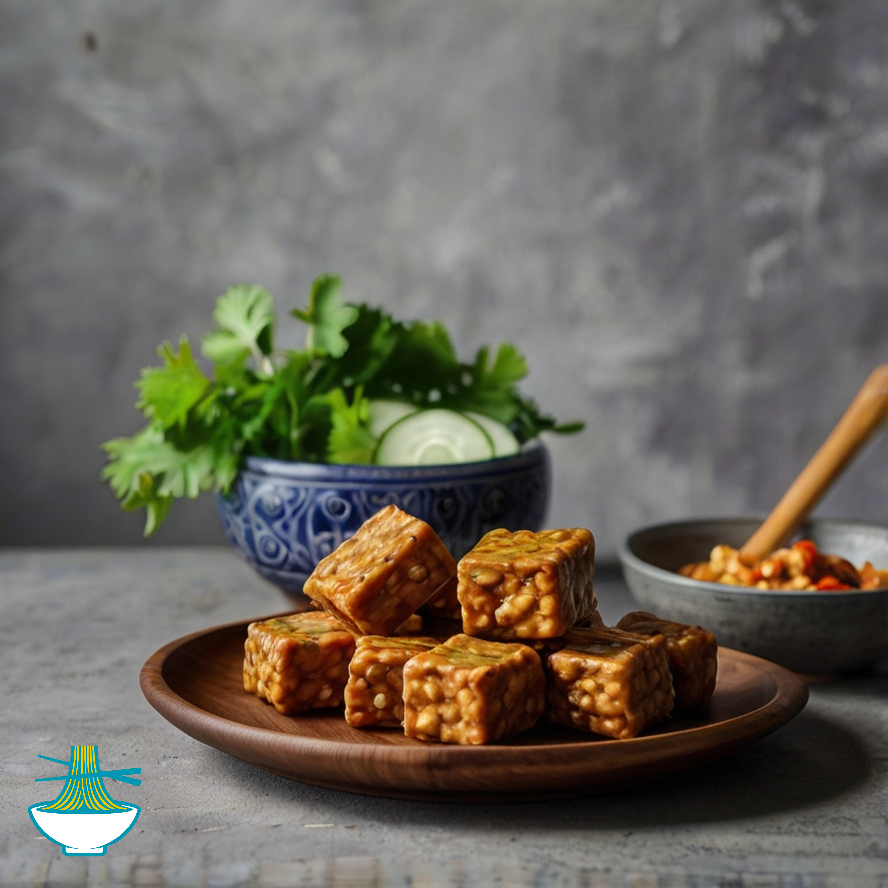Discover the rich tradition of Indonesia's beloved tempeh, a nutritious and versatile soy product made from fermented soybeans. Loved for its earthy flavor and firm texture, tempeh is a staple in Indonesian cuisine, offering a delightful blend of savory and nutty notes. Explore the history and cultural significance of tempeh, and learn how to incorporate this protein-rich delicacy into your cooking for a taste of authentic Indonesian flavor.
Here's a simple recipe for making traditional Indonesian tempeh at home:
Ingredients:
- 2 cups whole soybeans
- 2 tablespoons vinegar or 1 teaspoon tempeh starter
- 1/2 teaspoon tempeh culture (Rhizopus oligosporus)
- Banana leaves or parchment paper
Instructions:
1- Rinse the soybeans and soak them in water for about 6-12 hours, or overnight.
2- Drain the soybeans and remove the skins by rubbing them between your hands under running water.
3- Boil the soybeans in a large pot of water for 30 minutes, then drain and let cool.
4- In a bowl, mix the tempeh culture with the soybeans until well combined.
5- Place the soybean mixture on banana leaves or parchment paper, forming a thick layer.
6- Wrap the soybean mixture with the banana leaves or parchment paper and place it in a warm place (around 30-32°C or 86-90°F) for 24-48 hours to ferment. The tempeh should be firm and white with a nutty aroma when done.
7- Once fermented, store the tempeh in the refrigerator and use it within a week.
Enjoy your homemade Indonesian tempeh in stir-fries, curries, sandwiches, and more!
Nutritional Values :
Here are the approximate nutritional values for the main ingredients used in the traditional Indonesian tempeh recipe:
Whole Soybeans (2 cups, ~360g):
- Calories: 676 kcal
- Fat: 34g
- Carbohydrates: 56g
- Protein: 68g
Benefits:
- High in protein, making them an excellent plant-based protein source, supporting muscle repair and growth.
- Rich in healthy fats, particularly unsaturated fats, which can support heart health.
- Contains dietary fiber, which promotes digestive health and helps maintain stable blood sugar levels.
- Soybeans are also a good source of vitamins and minerals, including iron, calcium, magnesium, and B vitamins.
Vinegar (2 tablespoons):
- Calories: 6 kcal
- Fat: 0g
- Carbohydrates: 0.2g
- Protein: 0g
Benefits:
- Used to acidify the soybeans, creating an environment that helps the tempeh fermentation process.
- Has antibacterial properties that can aid in food preservation.
- May help control blood sugar levels and improve digestion.
Tempeh Starter (1 teaspoon):
- Nutritional Value: Negligible
Benefits:
- Contains spores of the Rhizopus mold, which is essential for fermenting the soybeans into tempeh.
- The fermentation process produces beneficial enzymes and enhances the digestibility of soybeans.
- Promotes the growth of probiotics, which are beneficial for gut health.
Tempeh Culture (Rhizopus oligosporus, 1/2 teaspoon):
- Nutritional Value: Negligible
Benefits:
- Specifically designed to ferment soybeans into tempeh, a process that creates a firm, protein-rich product.
- Enhances the bioavailability of nutrients in soybeans, making them easier to digest.
- May contribute to the production of B vitamins during fermentation.
Banana Leaves or Parchment Paper:
- Nutritional Value: Not consumed, so negligible.
Benefits:
- Used as a natural, breathable wrap that allows the tempeh to ferment properly while keeping it protected.
- Banana leaves can impart a subtle aroma to the tempeh, enhancing its flavor.
- Parchment paper is a suitable alternative if banana leaves are not available, providing a non-stick surface for fermentation.
Please note that these values are approximate and can vary based on the specific brand and type of ingredients used.


Comments